Application technology
Polymer coatings are the main option for finishing furniture facades. Depending on the complexity of the surface to be treated and the type of material, there are three options for applying decorative and protective coatings for furniture - lamination, lamination and post-formatting.
Lamination
The process of covering the base surface with facing materials in order to improve the aesthetic characteristics of the finished product is called lamination. The application technology is carried out at different temperatures on special equipment:
- cold lamination - cold processing with PVC foil for furniture facades is suitable for smooth surfaces. The part is covered with glue and the film is rolled under pressure;
- warm lamination - before applying the decorative coating, the glue is heated to release excess moisture. The material is pressed against the surface until the adhesive cures;
- hot lamination - the technology of application of the film is performed at a temperature of 120-160 ° C with hot rollers of machine tools.
In the production process, waste of PVC furniture film is formed if the material is deformed under the influence of a strong load. There are restrictions on the use of lamination when processing chipboard and MDF - the surface must be flat. The glue reliably fixes PVC, is evenly distributed over the base of the part due to temperature heating and the use of vacuum pressing equipment.
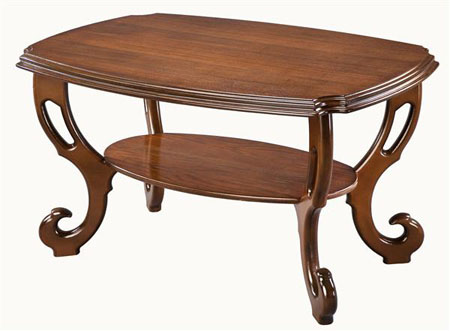
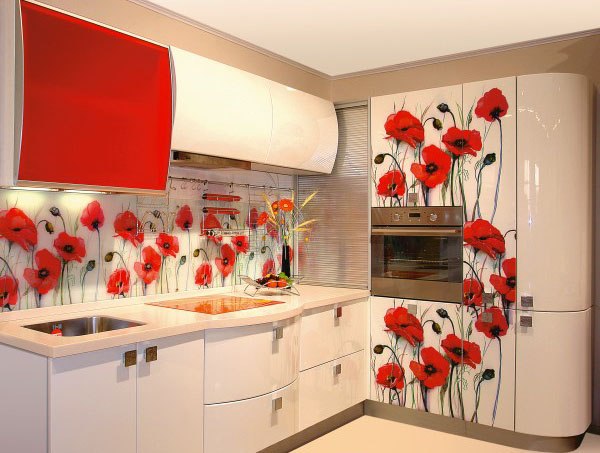

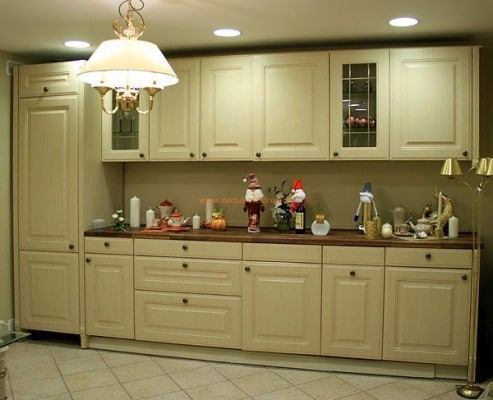
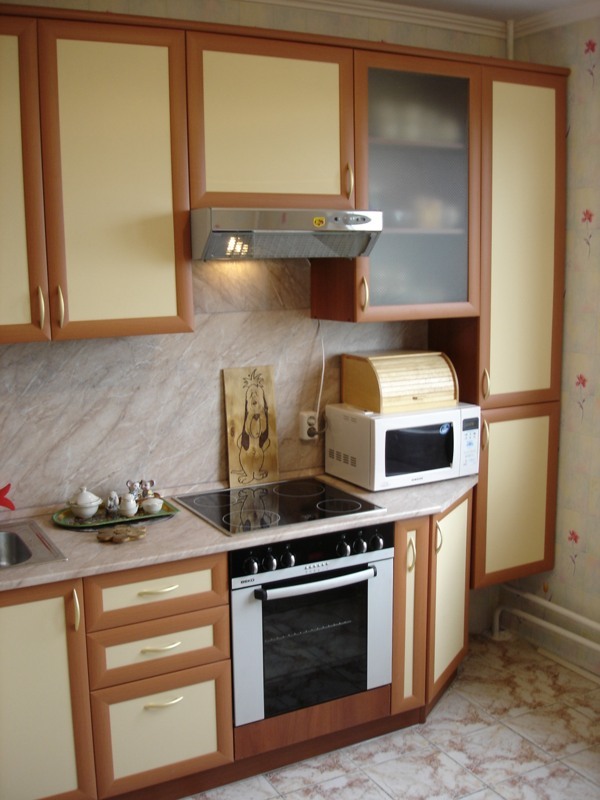
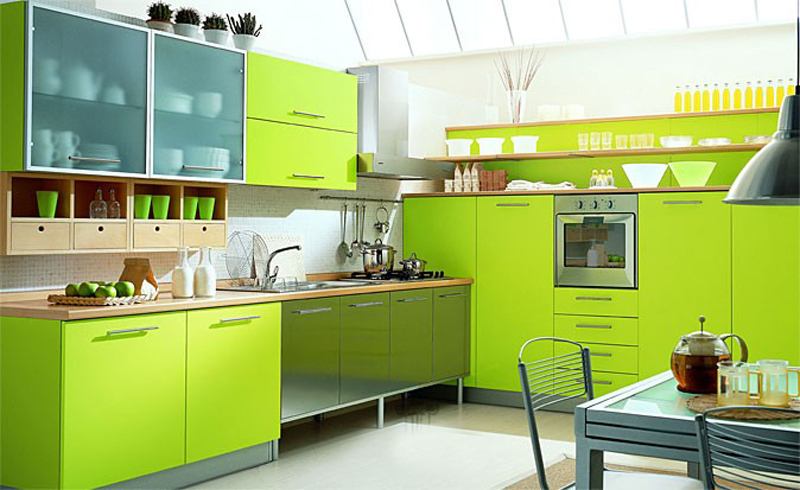
Lamination
During lamination, the processed product is wrapped with a film without applying glue. A durable protective coating is obtained by applying high temperature and pressure. The lamination technology allows the processing of structurally complex elements and uneven surfaces. The process features are as follows:
- at high temperatures, the furniture film becomes plastic;
- under pressure, the material is securely fixed to the base of the facade;
- the technology is suitable for processing elements made of MDF and chipboard;
- rolling of film material onto radial facades;
- for crimping, films coated with synthetic resins are used.
In the lamination process, a solid web is obtained that is not prone to delamination. Finished products are moisture resistant and chemically stable. If a factory defect occurs during the production process, the waste of PVC furniture film can be used for recycling.
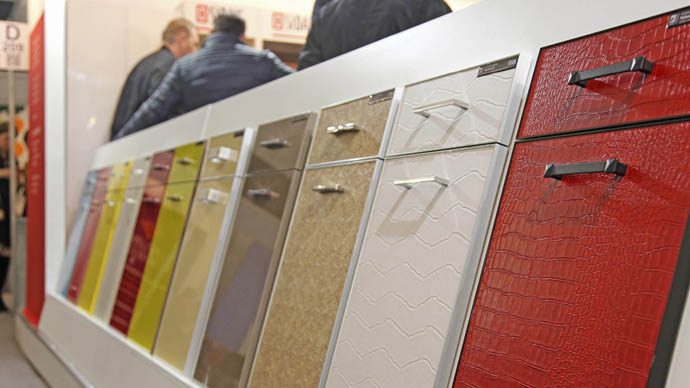



Postforming
The most effective way of processing MDF facades in furniture production is postforming. The essence of the process is to apply a layered coating to the base substrate. The material must be able to withstand the dynamic loading of the pressing equipment. The main differences of the technology:
- for post-formation, even polyvinyl chloride is used;
- process straight, curved, bent, radial facades;
- the coating is applied to the glue, mainly on positioning machines;
- the material is pressed with a press with a relief surface;
- an imprint is left on the facade, giving the product its original texture.
Applying various techniques for applying PVC on furniture facades, products can be given an original design. The material is presented in a wide range - there are options in restrained colors, strictly imitating natural materials, and films of bright and variegated colors for complex design compositions.
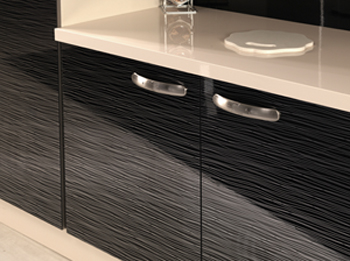

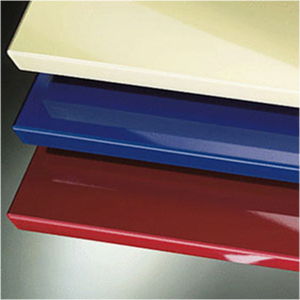

Technological features
The technology for the production of plastic facades involves gluing chipboard or fibreboard with thin plastic under a press. The edges of the canvases are pasted over on an edge-hemming machine.
There are different types of plastic for facades:
- roll plastic of medium and cold pressure (CPL);
- high pressure cladding (HPL) plastic sheet.
An interesting novelty is acrylic-based plastic. This material looks impressive. All the beauty comes from a pattern combining a matte background and glossy patterns, or vice versa. The photo below shows samples of plastic facades.
And this is not the whole palette of colors.
HPL plastic for facades
The price of sheet laminated plastic is higher than roll, but the quality of the facades will be impressive. The material is made of tough and hard sheets that hold their shape well and have excellent processing characteristics. They are labeled as HPL (high pressure laminate). This is an environmentally friendly material. Consumer reviews about him are positive.
Photo: HPL plastic looks pretty nice on the headset
Plastic sheets are produced by pressing special grades of paper. The sheets are impregnated with an absorbent to absorb the polymer resins. They transform paper into a durable multi-layer material.
CPL plastic for facades
Decorative plastic CPL (Continuous Pressure Laminate) resembles leatherette in its structure. Roll material has lower technological properties, but its price is also significantly lower.
In the photo - the kitchen doors are lined with CPL plastic. Looks pretty good too.
Roll plastic is made from polyvinyl chloride. On the net you can find reviews that it is less resistant to damage and in some cases it can fade in the sun. But outwardly, this finish looks harmonious.
Varieties of self-adhesive material
Manufacturers today offer a wide variety of options for decorative purposes. Polyvinyl chloride, propylene, polyester are most often used as the base material. To impart special properties, the composition is supplemented with coloring pigments, special stabilizing agents and modifiers. If the furniture facade has a flat and smooth surface, a facing product made using any technology is suitable for it. It can be high quality budget casting or another scheme.
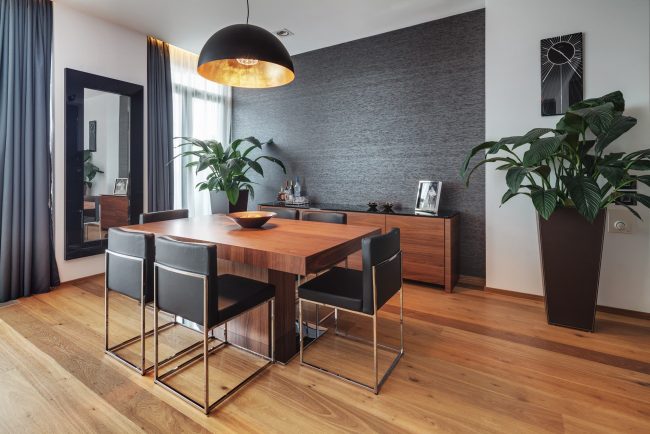
The table and sideboard are decorated with self-adhesive foil
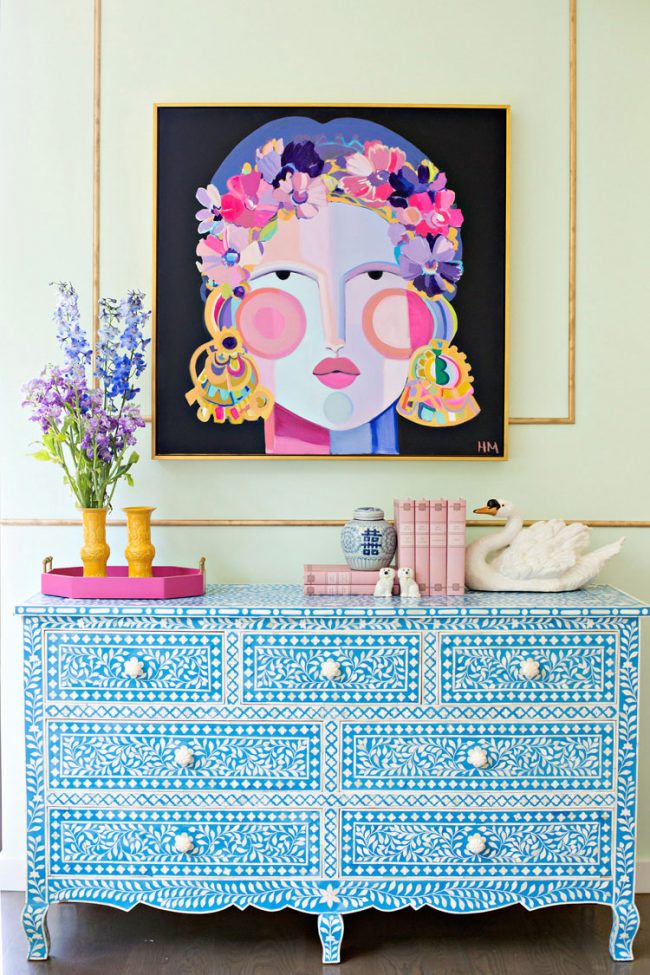
Stylish chest of drawers in blue and white with a decorative pattern
These elements also differ in adhesive bases, which can be made on the basis of rubber of any thickness. If the surfaces are flat, it is recommended to use a thicker layer of the compound, as well as concave or convex elements. Milled or engraved decorations are decorated with films with a thin adhesive layer.
14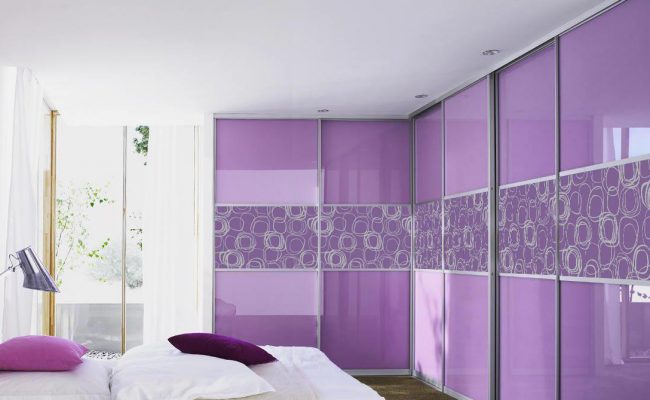
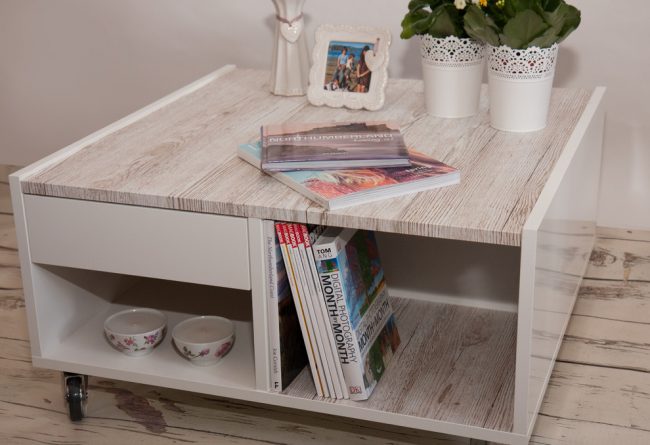

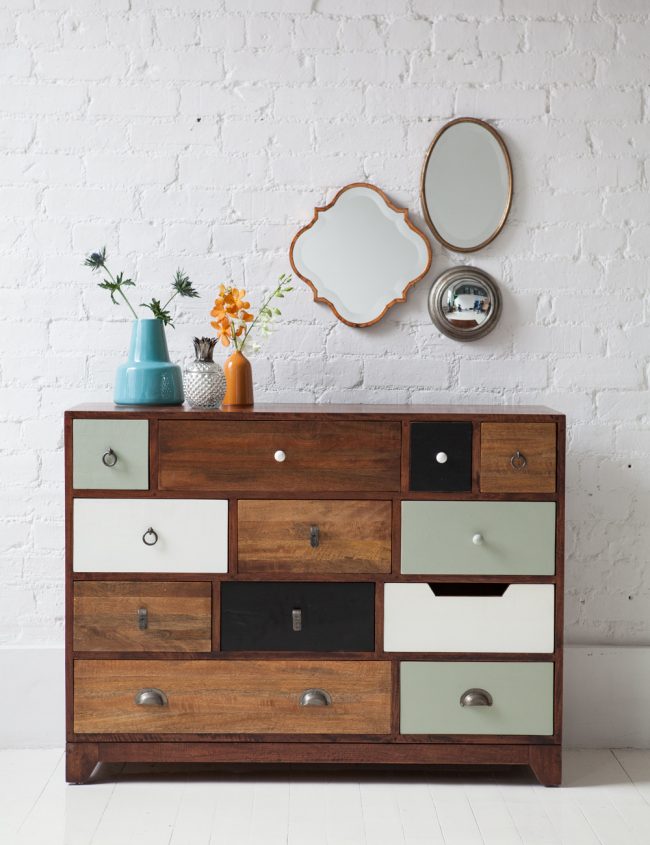
Three Questions Everyone Asks
Before buying a new headset, the first thing you do is read the reviews. Some buyers will say that such a facade is the best, because it is cheap. Others will talk about the problems they faced after several months of furniture operation.
Let's take a look at the three most common questions asked by the future owner of products with PVC film.
Why are some products very cheap and others not?
Here it is worth considering the process of making facades. The base of the headset is an MDF board, on which a film is applied. The minimum acceptable PVC thickness is 0.3 millimeters.
 The material is applied to the facades by means of thermal vacuum pressing, due to which the film fills all corners of the product, lies flat and retains its shape.
The material is applied to the facades by means of thermal vacuum pressing, due to which the film fills all corners of the product, lies flat and retains its shape.
Now let's answer the question. If the manufacturer deviates from the rules for making the headset and violates the technology, the facade can be incredibly cheap. Arriving at the store, you can see that products made with PVC film cover will have different prices from different manufacturers. The manufacturer could use a thin Chinese film with a thickness of 0.09 mm and poor quality glue instead of a press.
The film will peel off sooner or later, how to avoid it?
Indeed, the PVC film can peel off literally after a week of using the headset. Why is this happening?
 An iron will help to repair an edge with a peeled film.
An iron will help to repair an edge with a peeled film.
Let's go back to the first question. Violation of manufacturing technology can lead to such a problem. Also, the film may not withstand constant stress in the form of steam, water and temperature changes.
How to get out of the situation? Choose models for your kitchen from trusted manufacturers. Ask how the furniture is made. Install a powerful hood and make sure that the facades are used in a clean and dry environment.
 In the next photo, look at an example of a high-quality and well-maintained headset.
In the next photo, look at an example of a high-quality and well-maintained headset.
How to choose a high-quality facade out of all the models?
The answer is simple: don't go after the cheapest and best deal. As a rule, it is these products that lose their attractiveness after a few months.
Choose a headset for your kitchen, which is made in compliance with all technological processes.
Ask a consultant to tell you about the production, ask questions about the quality of the hardware, base and film.
Compare several models from different manufacturers. Better to overpay a little than to change the entire kitchen set in a year.
The main types of PVC films
Decorative vinyl film coverings are divided into several types, depending on the technology of their application.
Film for membrane vacuum pressing
It is intended for textured surfaces of furniture facades made of MDF - these are doors, shelves, countertops and other elements. The process is carried out using a special vacuum press. The film has a thickness of 0.25 to 0.5 mm. They use both monochromatic types and with various patterns or imitation of textures of natural materials.
Film for laminating smooth surfaces
This type is well suited for cladding smooth surfaces made of fiberboard or MDF, for example, panels for furniture, doors, window sills. Not all types of films are suitable for laminating chipboard due to the structural features of the boards themselves. In this case, the thinnest coatings are required, with a thickness of only 0.2 - 0.3 mm.
For lamination of profile molded products
When working with profile molded products, a machine is used for wrapping long parts with a film. A special laminate material with a thickness of 0.3-0.5 mm is used.
A similar technology is used to coat metal, wood, plastic and MDF products. In some cases, double-layer PVC films are used for lamination, which have additional protection against ultraviolet radiation.
Transparent protective film for furniture
For temporary protection of surfaces, transparent soft pvc film with a thickness of about 50 - 120 microns is used - it stretches well and is convenient to work with.
It is irreplaceable when transporting furniture or other products, both disassembled and assembled. It is clear that the thicker the material, the higher the degree of protection of the parts. A special glue applied to one of the sides reliably fixes the film on the surface, but does not leave any marks on it when removed.
Often, for advertising or warning purposes, inscriptions, logos or drawings are applied to such a coating.
For edge finishing of chipboard and MDF panels
To reliably protect the ends of furniture parts, which often receive significant shock loads, as well as to give them an aesthetic appearance, a special PVC edge film is used. It combines the qualities of elasticity and hardness, but it is quite difficult to glue it on your own, since this cladding should ideally be fastened using a special machine. In domestic conditions, a building hair dryer and good thermal glue are used for this. The edge fits equally well on chipboard and MDF.
Advantages and disadvantages of covering facades with a film
It is hard not to notice the kitchen made of film, since it is qualitatively distinguished by a large selection of colors, patterns and textures. The price of such a coating has long remained the lowest of all, since the production of facades covered with PVC foil is quite simple, although it requires vacuum equipment. In addition to the price advantages, the kitchen made of film is distinguished by the fact that this technology allows you to apply coatings even to embossed surfaces. This makes it possible to produce furniture of an expensive type, which is almost impossible to distinguish from completely wooden at first glance.
High-quality film facades are characterized by moisture resistance, high resistance to temperature and ultraviolet radiation. Due to the fact that the film completely covers the surface of the MDF or chipboard board, water does not get direct access to the inner parts of the furniture. A kitchen decorated with such material will serve for a very long time, keeping its original appearance.
PVC coatings provide high protection of furniture from mechanical stress, as they have high resistance to abrasion and are less shock-resistant than other types of materials.
For example, the surface of an MDF board requires careful sanding prior to film application. If you ignore this requirement, the glue will lie in an uneven layer, which in the future will lead to the appearance of bubbles under the film. The use of cheap, low-quality glue will cause the film to peel off, swell. In both cases, moisture will soon begin to accumulate under the film, damaging the properties of the furniture.
The main recommendations when choosing a coating for facades is not to skimp on its quality, since the appearance and service life of your kitchen furniture largely depends on this.
In conclusion, it is worth noting that although facade film is an inexpensive way to decorate furniture, its correct application in the factory or at home can guarantee a long service life and a beautiful appearance for your entire kitchen. A high-quality film acts as the first barrier that keeps moisture, temperature and other factors detrimental to furniture from penetrating into the wood, and the variety of colors and textures of this coating will refresh the kitchen and allow your furniture to stand out from others. The main thing is not to try to save money on the quality of the film, since not only the beauty of the furniture depends on it, but also your health.
Which is better: plastic or film on the kitchen facade
If MDF for the kitchen is the optimal basis for the facade, then there are always difficulties with the choice of the top layer. What to prefer: plastic, enamel, film? Evaluate the appearance, compare the cost, and, most importantly, determine exactly how much time you are willing to spend every day taking care of furniture.
Advantages and disadvantages of film headsets
The best combination of price, quality and aesthetics - for film facades with MDF-base. The material is unpretentious to maintain. Easy to clean with common household chemicals. The film can only deform under the influence of high temperature, steam. It is necessary to ensure that the sun's rays do not fall on the surface from the window.
The advantage is an unlimited number of design options, the ability to individually combine colors and textures, covering complex shapes.
Poppies on PVC film: designer kit
Matte film with a wood grain pattern is used to create classic headsets with carved facades.
Practical surface: no stains visible on the matte finish
Both film and plastic can serve as canvas for photo printing. Multi-colored drawings and photographs are also of practical value: they are less noticeable from water stains than on monochromatic glossy facades.
Bright and extraordinary kitchen: film on MDF
The designers combine several colors and textures in 2 basic shades, just like in this “chocolate” kitchen.
Floral printed wrap
Design and operation of plastic headsets
Plastic MDF facades look bright: rich colors, mirror shine. The material is not afraid of the sun, high temperatures and humidity levels. But glossy plastic panels require regular maintenance. Fingerprints remain on the mirror surface, splashes of clean water leave stains.
Semi-matte plastic textures are more practical than glossy ones.
The most fashionable color of the season in a plastic kitchen facade
Glossy plastic, even in a dark color, will make a small kitchen extraordinary and spacious.
Small set with a plastic front
Lovers of gloss will have to polish the kitchen to a shine every day.
Solid color set: zest - shade
The latest "squeak" in kitchen fashion: plastic in an aluminum profile.
Acid-colored plastic with aluminum edging
Painted MDF: stylish solutions for modern kitchens
Unlike plastic and film, enamel adheres perfectly to any surface. Painted facades require careful handling and specific maintenance. The lacquered enamel must not be cleaned with conventional products containing chlorine and some surfactants. Cleaning with powders is prohibited.
Gold painted kitchen: enamel on MDF
It is best not to use hard sponges. Under aggressive action, the varnish becomes covered with a mesh of small scratches, the surface loses its shine. You can restore the original appearance by polishing, but the upper protective layer becomes thinner during polishing. It will not be possible to carry out the procedure repeatedly.
Enamel is the choice for kitchens with complex facades.
Glossy red painted headset
A combination of two colors and an interesting solution for the shape of the doors: with longitudinal stripes and contrasting colors.
Anthracite and red: a successful combination of shape, color and shine
Futuristic 3D facades without external fittings. You just need to touch the door to open the cabinet. The laconic form and complex texture are a play of contrast.
Painted textured MDF panels
Airbrushing is a feature that emphasizes the uniqueness. Each drawing is created only once.
Kitchen with a twinkle: airbrushing on enamel
Veneer and solid wood: the luxury of natural wood ↑
Veneer is increasingly being combined with other facade decoration options. For example, a patina, enamel or varnish is applied to a veneered facade. Facades with veneer are combined in one set with painted or film panels.
Patinated veneer on MDF
The veneer in a warm golden hue contrasts with the black gloss of the plastic and the photo printing on the dark glass of the apron - an interesting idea.
Design project: veneer in one set with plastic and glass
The veneer in a fashionable light-colored zebrano texture will perfectly fit into a small modern kitchen with a snow-white top tier of cabinets.
Film and veneered MDF in one set
Video: how facades are made with PVC film ↑
Video: the manufacturer shows the whole process of covering MDF panels with decorative film.
If you are at a loss with the choice of finishing decor, contact the designer. A specialist will advise which type of coating will be the best for your kitchen unit. When ordering an individual production, be sure to ask what material the base is made of. Find out which manufacturer's materials are used to cover the facades. Ask for a warranty in case there is a problem with the topcoat.
Film, enamel or plastic - which is better?
Along with the film finish, enamel, acrylic or plastic coating is popular. At first glance, it is difficult for an uninformed buyer to determine the material used for the manufacture of furniture facades. How is the film different from plastic and enamel? What is the best choice? To answer these questions, you need to know the main features of these materials.
Plastic facades of MDF. Plastic facades have a bright glossy surface. Such facades are resistant to mechanical damage, do not deform from exposure to moisture or high temperature, do not fade in the sun.The colors are varied, but the palette is not as wide as that of the film. Plastic facades are perfect for kitchens, bathrooms or hallways. The disadvantages include a higher cost compared to film facades, as well as the fact that handprints are clearly visible on plastic. Restoration, as in the case of the film, is not possible.
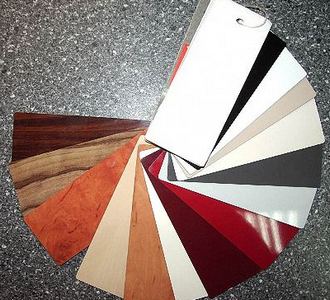
Acrylic facades. Coating furniture facades with acrylic is a new technology for us. This process is quite complicated, therefore, furniture with acrylic facades cannot be called cheap. Acrylic has an even smoother and more glossy surface than plastic. This can be considered both an advantage and a disadvantage: the excessive shine of the furniture, although beautiful, can be very tiring, besides, fingerprints will also have to be eliminated. Acrylic is environmentally friendly, does not contain harmful impurities. It is much more resistant to mechanical damage than plastic or film. Bright, saturated color does not fade over time, does not fade in the sun. But acrylic facades cannot boast of a variety of forms: they are only deaf and even. If you need furniture of more complex shapes, you will have to make a choice in favor of film or painted facades.
MDF facades covered with enamel. Painted facades (enamel) can cause bewilderment among uninformed buyers: they are simply painted, why are they so expensive? The fact is that coating MDF with enamel is a technologically complex, multi-stage process. First, the surface of the slab is primed, then enamel is applied in several layers, carefully drying each of them. After that, the paint layer is sanded, varnished and polished. The result is an environmentally friendly product that is resistant to light and minor mechanical damage. The main advantages of enamel facades are the possibility of restoring a scratched surface (and this is a big plus compared to the film!), A huge variety of color palette (more than 700 colors!) And special effects (metallic, chameleon, mother of pearl, galaxy, pearls, etc.). There are four main textures: high gloss, gloss, matte, abrasive surfaces. Among the shortcomings can be called a high price and, again, handprints.
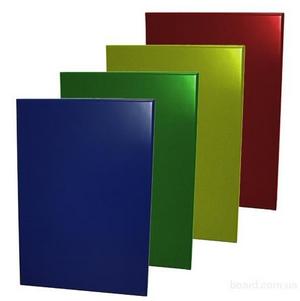
Film, plastic or painting: which is better? What kind of furniture to choose depends on the priorities of the buyer. If you need special strength, brightness and durability and there is no need to strictly save when ordering, plastic or acrylic will do. Enamel facades are chosen by those for whom the price is not important, but requires, for example, unusual colors or special resistance to sunlight
With a small budget, you should pay attention to high-quality, fairly durable and easy-care furniture with film facades. The difference in price between enamel and film can be very significant, amounting to tens of thousands of rubles, if you order, for example, furniture for a large kitchen
Advantages and disadvantages
As with any materials, PVC films for furniture facades have both pros and cons. The main advantage of the canvas is the combination of decorative and protective functions. After processing, the product receives an interesting design, in addition, the film does not deform, is resistant to soot, and is waterproof.
Pros:
- cost - prices for PVC film for facades are low, it all depends on the specific model;
- ease of application - the canvas is very easy to apply to furniture;
- practicality - the PVC product does not deform, is waterproof, does not fade;
- safety - the canvas is environmentally friendly, so you don't have to be afraid for your health;
- wide choice - a lot of film options of different shades and textures open before the buyer.


Minuses:
- low strength - the canvas can be easily scratched;
- impossibility of restoration - the canvas is not restored either by polishing or grinding;
- low temperature threshold - for the kitchen, the film will not be the best solution, since even a hot mug can leave a trace on it.
The canvas has more pluses than minuses.If the film comes into contact with detergents, it remains intact. It can be used to decorate furniture in rooms with fluctuating humidity levels. The coating protects the wood from burning out and prevents mold from forming.
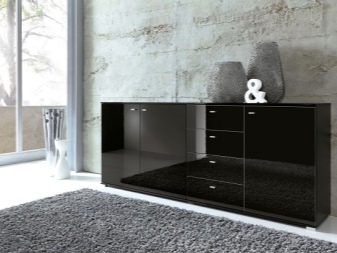
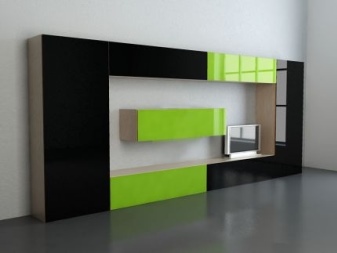
How to choose?
There are several criteria to rely on when choosing a coating, and the main ones are conformity to design and minimization of waste during pruning. The first step is to decide which type of film is suitable for the furniture facade. Usually, for a classic interior, a film that imitates a tree is chosen. The color - light or dark - is chosen depending on the general concept of the room, floor and wall finishes.
Classic implies the use of a white coating. Lovers of catchy, bright design options can choose a film in red, blue or yellow colors. Often the coating is used for the kitchen apron - self-adhesive is perfect in this case. When choosing, you should focus on the purpose of the purchase, because each material is different from each other.
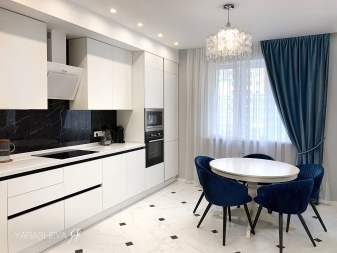
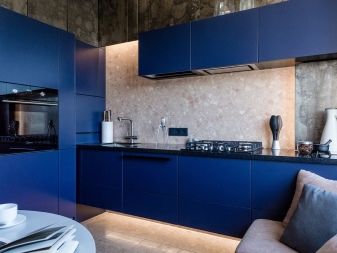
Before choosing a film, it is advisable to decide on the appearance of the facade, as well as on its shape. Most kitchens made of MDF are covered with a film in production that is not afraid of water and is resistant to damage. PVC foil is not covered with slabs, but ready-made facades. There are a lot of film design options, but the most popular is wood-like coating for MDF.
In this case, not only the shade is imitated, but the drawing is also transmitted. Together with milling, the veneered furniture facade does not look different from the wooden one. For classic-style kitchens, aged facades are willingly created: an artificial patina is applied over the film, which visually makes the wood look old.

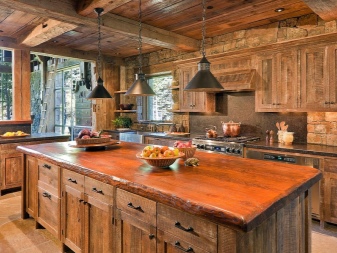
Caring for film coatings is incredibly easy. Both dry and wet cleaning are suitable for them - it is enough to wipe the furniture with a damp cloth. It is forbidden to use cleaning agents that contain abrasive substances, as well as brushes and other devices for mechanical cleaning - they leave scratches on the PVC film. Having learned about what films are, what characteristics they have, you can make a good purchase that will last a long time.
For information on how to glue PVC film on furniture, see the next video.
Leading manufacturers of PVC films for furniture facades and material prices
A similar technological material is produced in many countries, most of which supply it to the Russian market. If desired, among the huge assortment, you can always choose the desired shade and texture. The following brands are in particular demand:
- The Italian company ALFATHERM presents a wide selection of colors and textures of the ALFAWOOD film for furniture decoration. The company specializes in calm, natural motives and shades, which allows you to create harmony in any interior. The cost of vinyl film, depending on the specific type and volume of delivery, varies from 100 to 350 rubles. per sq. meter.
- The Russian market was flooded with inexpensive products from numerous Chinese firms - Shanghai, Foshan Nanhai, Huangshan City Dongyi, and the Premium series, which are used in membrane vacuum pressing. This is the case when the product is really high quality. Despite the fact that production is located in East Asia, such a film coating often has a European design and can be bought for 50-100 rubles;
- Concerns LG HAUSYS and "Dae Yang Co." (Korea) are guided by European fashion trends. They produce a wide range of film products, which are dominated by imitations of different types of wood, stone, as well as velvet, silk, mother-of-pearl surfaces and unusual fantasy decors. The cost of products from South Korean manufacturers is from 80 to 200 rubles per sq. meter;
- German films of the firms KLÖCKNER PENTAPLAST and RENOLIT of the Prestige class are also very popular and in demand among manufacturers of furniture, doors and windows.In the Prestige series, you can find samples in classic or extravagant styles, from the simplest to the ultra-modern. Companies follow the latest fashion trends and try to adhere to these trends. Such products are, perhaps, the most expensive - the price for them can reach 400 - 450 rubles.
Also on sale are samples of film products for the facades of Russian, Israeli, Spanish and other manufacturers with a range of prices from 70 to 400 rubles per square meter. meter.
The use of vinyl flooring has literally revolutionized the furniture industry. It became possible without much difficulty to implement the most daring design ideas, to create interior items that practically do not differ from those made from natural materials. It is not surprising that the demand for such a material is growing from year to year.
How to choose a film for furniture
To give new life to an outwardly worn out, but still strong headset, pasting the kitchen facades with foil will help. This idea is also useful for changing the interior of the room.
In order for the updated product to be beautiful and practical, you should competently approach the choice of self-adhesive material.
Types of films
Several types of films are used for furniture:
- made of PVC (polyvinyl chloride);
- polyester;
- polypropylene.
These materials have similar properties. They are moisture resistant, resistant to abrasion, high temperatures, and physical stress. Do not react to components of solvents and household chemicals.
Films are smooth and textured, imitating fabric, leather, pile.
Most often, vinyl materials are used to decorate furniture.
Single-layer films are made of PVC-compound with an adhesive layer covered with paper. In two-layer versions, a paper or fabric backing is added under the polymer.
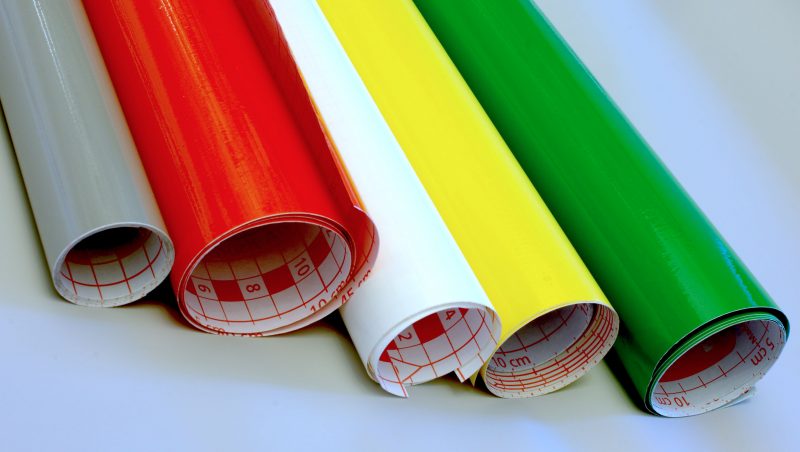
Color selection
The design variability is not limited. Films are:
- Monochrome. The light palette refreshes the room. Yellow, orange, pink shades contribute to a good mood, increase appetite. Blue, blue, purple soothes. Greens help to achieve harmony. Black, white, red are best combined with each other or with other colors. Dark tones are appropriate in a well-lit room.
- Under the tree, stone. Always relevant in the kitchen, they fit into almost any interior.
- With imitation of fabric or leather. Such a film will help in creating an interesting, unusual design.
- With various images, drawings, patterns. Absolutely everything can be reproduced on them: city landscapes, nature, animals, abstractions.
- With photo printing. You can make a custom film with any chosen photo or an exclusive image, your own design.
In order not to get confused in the variety of patterns and colors, base your choice on the general concept of the kitchen interior. The renewed set should match the color of the walls and other furniture in the room, and the facades should match the shade of the countertop.
Selecting an effect
In addition to color, materials for pasting furniture have a different finish:
- Glossy. Ideal for use in dimly lit kitchens as it reflects and diffuses light. The surface to be pasted should be perfectly smooth: glossy vinyl emphasizes the smallest irregularities of the renewed canvas.
- Matt. Versatile, in any light and in various colors it looks restrained.
- Metallized. Monochromatic fronts with a metallic sheen add radiance and brightness.
- Mirror. Visually expands the space, brightens the dark room.
- Holographic. Has a shine and three-dimensional effect.
Which solution is better: plastic, PVC or enamel
The answer to this question cannot be unambiguous, since any option has its own advantages and disadvantages.
-
Enamel is a coating of painted facades that protects them with high quality. This is the optimal solution for design styles such as classic and provence. In texture, it resembles a glossy ceramic tile.Such headset facades are best covered with patina. But their high price is due to the complex painting technology and the cost of materials. In addition, washing such a cabinet is not so easy: the doors should be carefully wiped with a damp cloth, but in no case with abrasive agents, like glass, especially if the color of the furniture is white. Even the imitation of wood-like coating hides the smallest scratches, and the white shade demonstrates how carefully the owners treat things.
-
Plastic as a coating for MDF facades is a universal solution. Customer reviews indicate that even a white kitchen cabinet with such a finish is practical and easy to clean, since plastic is not at all afraid of abrasive detergents, and besides, they can be washed even with a stiff brush. The price of such options is lower than for painted models, but higher than for those covered with PVC film.
-
The most economical option is to cover it with a film. Its price is lower compared to other methods of facade decoration due to a simple gluing technology, although the design of finished products is diverse: here there is also a film for tiles, with a pattern and photo printing, imitation wood or stone, patina coating (this technology is often found in Provence styles or classic). Kitchen furniture with film facades, as seen in the photo below, can be varied in design. But in general, the quality of the film is, of course, inferior to enamel and denser plastic. Although the problem may be identical: like plastic, the film coating peels off after a while.
Obviously, it is only the buyer himself who can decide which facade finish is better, depending on factors such as the availability of funds, the style and design of the kitchen, and the particulars of caring for it. The most economical are the doors covered with PVC foil.
